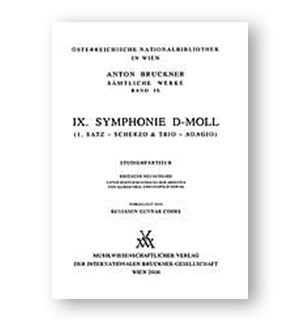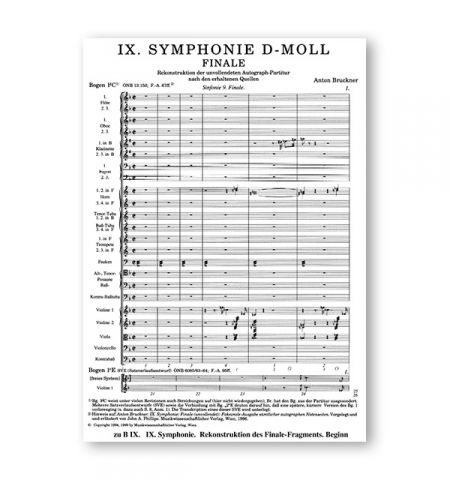ANTON BRUCKNER
Complete Edition (until 2014)
Symphony No. 9 in D minor

First Movement - Scherzo & Trio - Adagio
3,3,3,3,-8(5-8+WagnerTb),3,3,1-Timp-Str / 60'
B 9-STP: Study score (2nd revised edition 2005)
ISMN 979-0-50025-249-8
B 9-DIR: Conductor's score (2nd revised edition 2005)
ISMN 979-0-50025-262-7
B 9-RVB: Critical report by Benjamin Gunnar Cohrs (2001)
ISBN 978-3-900270-53-7 / ISMN 979-0-50025-222-1
* Performance material for hire
read on
Leopold Nowak could not realize his plan of a new edition of the Ninth, the 1951 edition of which was only in fact a corrected reprint of the pre-war Orel edition. When Benjamin Gunnar Cohrs was drawing up the critical report on the three completed movements of the symphony, the abundance of new detail which had emerged provided a compelling argument for producing a new score. Bruckner habitually left putting in the final dynamic and agogic nuances until after the completion of the whole work, and was prevented from doing this not only in the Finale but also in the three 'complete' movements. New findings related to this fact are taken into consideration in Cohrs' new score, which also contains a detailed commentary section, incorporated in a way that does not interfere with the general look of the score itself.

Finale Fragment (1895/96)
B 9/4-STP: Study score (revised edition 1999)
ISMN 979-0-50025-211-5
B 9/4-FKS: Facsimile edition of all autograph pages
ISMN 979-0-50025-133-0
B 9/4-DOK: 'Documentary score', specifically for use in concert performance (2002)
ISMN 979-0-50025-232-0
* Performance material for hire
read on
Bruckner left the Finale of his Ninth Symphony unfinished. The consecutive numbering of the four-page manuscript sheets shows that part of the autograph material has been lost. Close examination of the existing sources refutes the notion that the extant material simply contains confused sketches; on the contrary, the numerous sketches and pages of full and short score are evidence that Bruckner was working according to a clear and bold concept. Nobody can say what shape and form Bruckner would finally have given to this his last Finale. Abstaining from speculation of any kind, the Bruckner Complete Edition reconstructs this mighty torso on the exclusive basis of the composer's autographs and a critical screening and ordering of the sources.
The 136 pages of music in the study score follow Bruckner's own pagination and are followed by six pages of the composer's sketches and notes for the coda. The German-English text section contains an instructive foreword, a chapter 'On the Edition', and synoptic charts on the sources.
In the so-called "Documentary score" Phillips prepared the Finale fragment with the greatest care for performance in concert, leaving gaps for verbal commentary. This documentation was given its first performance by the Vienna Symphony Orchestra under Nikolaus Harnoncourt in the Golden Hall of the Vienna Musikverein in November 1999.
Second Movement: Scherzo and Trio. Monograph.
B 9/2-Q
ISMN 979-0-50025-182-8
Published by Doblinger:
Trio No. 1 in F major (1889)
Trio No. 2 in F sharp major (1893)
Edited for concert performance with a critical report
by Benjamin Gunnar Cohrs
74 015: Score
ISMN 979-0-012-18489-8
* Performance material for hire
read on
In order to make Bruckner's work in its preliminary stages more accessible to concert audiences, Doblinger published an edition of the 1893 Trio carefully prepared for performance purposes, and a transcription for viola and organ, both by Benjamin Gunnar Cohrs.